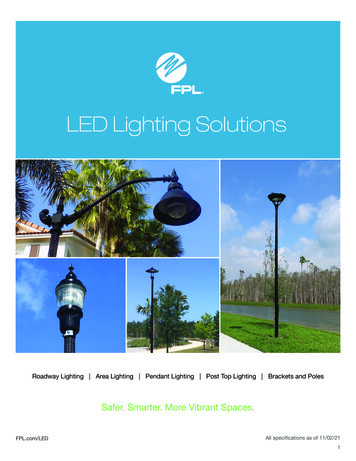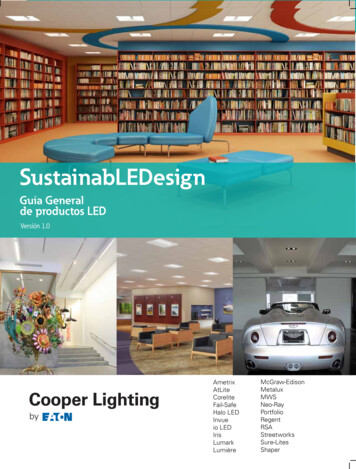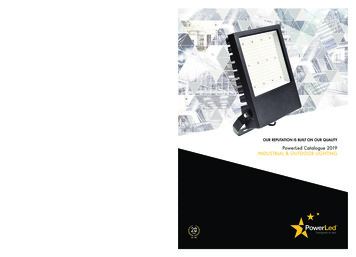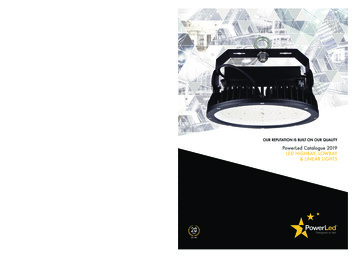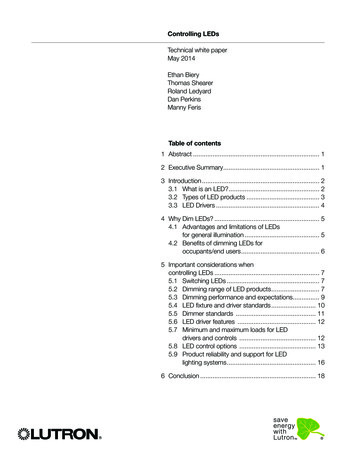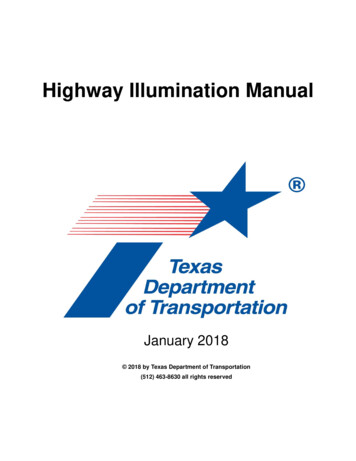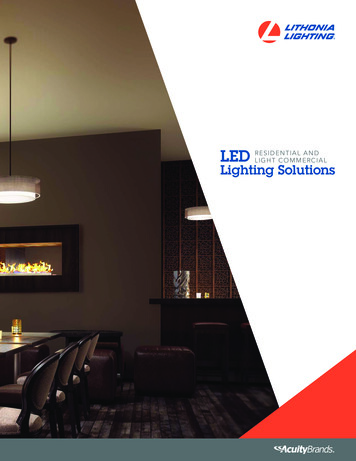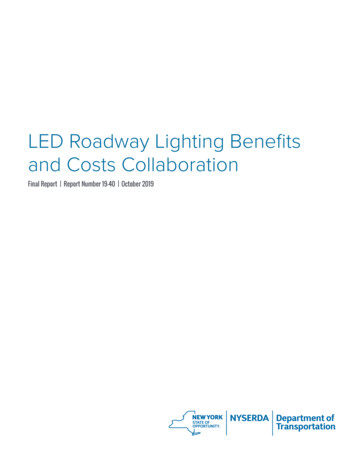
Transcription
LED Roadway Lighting Benefitsand Costs CollaborationFinal Report Report Number 19-40 October 2019NYSERDA Department ofTransportation
LED Roadway Lighting Benefitsand Costs CollaborationFinal ReportPrepared for:New York State Energy Research and Development AuthorityAlbany, NYPatrick BoltonSenior Project ManagerNew York State Department of TransportationAlbany, NYOwais Memon, P.E.Project ManagerPrepared by:Lighting Research Center, Rensselaer Polytechnic InstituteTroy, NYJohn D. BulloughDirector of Transportation and Safety Lighting ProgramsLeora C. RadetskyResearch ScientistNicholas P. SkinnerLead Research SpecialistNYSERDA Report 19-40NYSERDA Contract 83173DOT Task Assignment C-15-08November 2019
NoticeThis report was prepared by the Lighting Research Center at Rensselaer Polytechnic Institute in thecourse of performing work contracted for and sponsored by the New York State Energy Research andDevelopment Authority and the New York State Department of Transportation (hereafter the "Sponsors").The opinions expressed in this report do not necessarily reflect those of the Sponsors or the State of NewYork, and reference to any specific product, service, process, or method does not constitute an implied orexpressed recommendation or endorsement of it. Further, the Sponsors, the State of New York, and thecontractor make no warranties or representations, expressed or implied, as to the fitness for particularpurpose or merchantability of any product, apparatus, or service, or the usefulness, completeness, oraccuracy of any processes, methods, or other information contained, described, disclosed, or referred to inthis report. The Sponsors, the State of New York, and the contractor make no representation that the useof any product, apparatus, process, method, or other information will not infringe privately owned rightsand will assume no liability for any loss, injury, or damage resulting from, or occurring in connectionwith, the use of information contained, described, disclosed, or referred to in this report.NYSERDA makes every effort to provide accurate information about copyright owners and relatedmatters in the reports we publish. Contractors are responsible for determining and satisfying copyright orother use restrictions regarding the content of the reports that they write, in compliance with NYSERDA’spolicies and federal law. If you are the copyright owner and believe a NYSERDA report has not properlyattributed your work to you or has used it without permission, please email print@nyserda.ny.govInformation contained in this document, such as web page addresses, are current at the timeof publication.New York State Department of Transportation DisclaimerThis report was funded in part through grant(s) from the Federal Highway Administration and the UnitedStates Department of Transportation, under the State Planning and Research Program, Section 505 ofTitle 23, U.S. Code. The contents of this report do not necessarily reflect the official views or policy ofthe United States Department of Transportation, the Federal Highway Administration, the New YorkState Department of Transportation, or the New York State Energy Research and Development Authority.This report does not constitute a standard, specification, regulation, product endorsement, or anendorsement of manufacturers.ii
Technical Report Documentation Page1. Report No.2. Government Accession No. 3. Recipient’s Catalog No.4. Title and Subtitle5. Report DateLED Roadway Lighting Benefits and Costs CollaborationNovember 20197. Author(s)8. Performing Organization Report No.19-406. Performing Organization Code:J. D. Bullough, L. C. Radetsky and N. P. Skinner9. Performing Organization Name and Address10. Work Unit No.11. Contract or Grant No.Lighting Research CenterRensselaer Polytechnic Institute21 Union StreetTroy, NY 12180Contract No. 8317312. Sponsoring Agency Name and Address13. Type of Report and PeriodNew York State Energy Research and Development Authority17 Columbia CircleAlbany, NY 12203Final Report (2016-2019)14. Sponsoring Agency CodeNew York State Department of Transportation50 Wolf RoadAlbany, NY 1223215. Supplementary NotesPatrick Bolton from NYSERDA and Owais Memon from NYSDOT served as project managers.16. AbstractThe use of light emitting diode (LED) roadway lighting is growing throughout New York State and the rest of thecountry, because of the potential for longer effective life an energy savings compared to high pressure sodium(HPS) lighting systems. While the technological feasibility of LED roadway lighting systems has been established,the impacts of LEDs on the economics of roadway lighting are situationally dependent. In many municipalities,roadway lighting is owned and maintained by the local electric utility. Entitles such as the New York StateComptroller’s Office have advocated for municipalities to purchase their roadway lighting systems from the utility,and economic analyses suggest a substantial cost savings can be achieved in this way. Utility-owned roadwaylighting is still attractive, however, for many municipalities who are not prepared to purchase and maintain theirlighting network. In the present project, LED luminaires were installed along a major arterial roadway by the localutility. The LED lighting was selected to improve the visual conditions while using less energy. Over 30% energysavings were realized, although utility costs were not reduced by the same amount. Subjective evaluations of theprevious HPS and each type of LED, revealed that the LED lighting was judged to be an improvement over theHPS lighting conditions.17. Key Words18. Distribution StatementSolid state lighting; Light emitting diodes, Utilitytariffs19. Security Classif. (of thisreport):UnclassifiedForm DOT F 1700.7 (8-72)20. Security Classif. (of thispage):Unclassified21. No. ofPages 5922. PriceReproduction of completed page authorized.iii
AcknowledgmentsThis project was sponsored by the New York State Energy Research and Development Authority(NYSERDA) and the New York State Department of Transportation (NYSDOT) through ProgramOpportunity Notice (PON) 3090, Integrated Mobility Solutions for Smarter Cities and Communities.Patrick Bolton from NYSERDA and Owais Memon from NYSDOT served as project managers. JosephTario from NYSERDA is the former NYSERDA project manager. Many individuals and organizationscollaborated on this project: Robert Terry, Mark Kennedy and Shawn Raymond from NYSDOT; CamilleKamga and Penny Eickemeyer from the Region 2 University Transportation Research Center (UTRC),which provided cost sharing; John Walter, Caeresa Richardson, Jennifer Kellish, Kevin George,Kristoffer Kiefer and James Klein from National Grid, which provided in-kind support; Sandra Misiewiczand Christian Bauer from the Capital District Transportation Committee (CDTC), which provided in-kindsupport; John Cunningham, Jack Spath and Judy Ekstrom from the Town of Colonie, which provided inkind support; Mayor Frank Leak, Deputy Mayor Michael Aidala, Lester Decker, Henry DeCotis, JamieBlot, Julianne Okun and Chris Bisognano from the Village of Colonie, which provided in-kind support;and Stephan Godlewski and Gregory Gibbons from Creighton Manning.Preferred CitationNew York State Energy Research and Development Authority (NYSERDA). 2019. “LED RoadwayLighting Benefits and Costs Collaboration,” NYSERDA Report Number 19-40. Prepared by LightingResearch Center, Rensselaer Polytechnic Institute, Troy, NY. nyserda.ny.gov/publicationsiv
Table of ContentsNotice .iiNew York State Department of Transportation Disclaimer .iiTechnical Report Documentation Page .iiiAcknowledgments .ivPreferred Citation.ivList of Figures .viAcronyms and Abbreviations .viiiExecutive Summary .ES-11Background .12Previous Conditions .334562.1Energy and Economics. 32.2Lighting System Performance . 42.3Survey Questionnaire Evaluation . 6Selection of LED Luminaires.143.1Photometric Performance . 143.2LED Luminaire Locations. 153.3Logistical Planning . 16New Conditions .184.1Energy and Economics. 184.2Lighting System Performance . 194.3Survey Questionnaire Evaluation . 20Conclusions .475.1Discussion. 475.2Statement on Implementation . 48References .49Appendix A. Route 5 Crosswalk Lighting Analysis: Existing LightingValues—Measured .A-1v
List of FiguresFigure 1. HPS Luminaire Type .4Figure 2. Central Avenue with HPS Lighting .5Figure 3. Response to Survey Question 1—HPS .7Figure 4. Response to Survey Question 2—HPS .7Figure 5. Response to Survey Question 3—HPS .8Figure 6. Response to Survey Question 4—HPS .8Figure 7. Response to Survey Question 5—HPS .8Figure 8. Response to Survey Question 6—HPS .9Figure 9. Response to Survey Question 7—HPS .9Figure 10. Response to Survey Question 8—HPS .9Figure 11. Response to Survey Question 9—HPS .10Figure 12. Response to Survey Question 10—HPS .10Figure 13. Response to Survey Question 11—HPS .10Figure 14. Response to Survey Question 12—HPS .11Figure 15. Response to Survey Question 13—HPS .11Figure 16. Response to Survey Question 14—HPS .11Figure 17. Response to Survey Question 15—HPS .12Figure 18. Response to Survey Question 16—HPS .12Figure 19. Response to Survey Question 17—HPS .12Figure 20. Response to Survey Question 18—HPS .13Figure 21. LED and HPS Performance—Preliminary Analysis .14Figure 22. LED Luminaire Locations .16Figure 23. Central Avenue with LED Lighting .20Figure 24. Response to Survey Question 1—LED A (3000 K).21Figure 25. Response to Survey Question 2—LED A (3000 K).21Figure 26. Response to Survey Question 3—LED A (3000 K).22Figure 27. Response to Survey Question 4—LED A (3000 K).22Figure 28. Response to Survey Question 5—LED A (3000 K).22Figure 29. Response to Survey Question 6—LED A (3000 K).23Figure 30. Response to Survey Question 7—LED A (3000 K).23Figure 31. Response to Survey Question 8—LED A (3000 K).23Figure 32. Response to Survey Question 9—LED A (3000 K).24Figure 33. Response to Survey Question 10—LED A (3000 K).24Figure 34. Response to Survey Question 11—LED A (3000 K).24Figure 35. Response to Survey Question 12—LED A (3000 K).25Figure 36. Response to Survey Question 13—LED A (3000 K).25Figure 37. Response to Survey Question 14—LED A (3000 K).25Figure 38. Response to Survey Question 15—LED A (3000 K).26Figure 39. Response to Survey Question 16—LED A (3000 K).26Figure 40. Response to Survey Question 17—LED A (3000 K).26Figure 41. Response to Survey Question 18—LED A (3000 K).27Figure 42. Response to Survey Question 1—LED A (4000 K), East and West Sections .27vi
Figure 43. Response to Survey Question 2—LED A (4000 K), East and West Sections .27Figure 44. Response to Survey Question 3—LED A (4000 K), East and West Sections .28Figure 45. Response to Survey Question 4—LED A (4000 K), East and West Sections .28Figure 46. Response to Survey Question 5—LED A (4000 K), East and West Sections .28Figure 47. Response to Survey Question 6—LED A (4000 K), East and West Sections .29Figure 48. Response to Survey Question 7—LED A (4000 K), East and West Sections .29Figure 49. Response to Survey Question 8—LED A (4000 K), East and West Sections .29Figure 50. Response to Survey Question 9—LED A (4000 K), East and West Sections .30Figure 51. Response to Survey Question 10—LED A (4000 K), East and West Sections .30Figure 52. Response to Survey Question 11—LED A (4000 K), East and West Sections .30Figure 53. Response to Survey Question 12—LED A (4000 K), East and West Sections .31Figure 54. Response to Survey Question 13—LED A (4000 K), East and West Sections .31Figure 55. Response to Survey Question 14—LED A (4000 K), East and West Sections .31Figure 56. Response to Survey Question 15—LED A (4000 K), East and West Sections .32Figure 57. Response to Survey Question 16—LED A (4000 K), East and West Sections .32Figure 58. Response to Survey Question 17—LED A (4000 K), East and West Sections .32Figure 59. Response to Survey Question 18—LED A (4000 K), East and West Sections .33Figure 60. Response to Survey Question 1—LED B .33Figure 61. Response to Survey Question 2—LED B .33Figure 62. Response to Survey Question 3—LED B .34Figure 63. Response to Survey Question 4—LED B .34Figure 64. Response to Survey Question 5—LED B .34Figure 65. Response to Survey Question 6—LED B .35Figure 66. Response to Survey Question 7—LED B .35Figure 67. Response to Survey Question 8—LED B .35Figure 68. Response to Survey Question 9—LED B .36Figure 69. Response to Survey Question 10—LED B .36Figure 70. Response to Survey Question 11—LED B .36Figure 71. Response to Survey Question 12—LED B .37Figure 72. Response to Survey Question 13—LED B .37Figure 73. Response to Survey Question 14—LED B .37Figure 74. Response to Survey Question 15—LED B .38Figure 75. Response to Survey Question 16—LED B .38Figure 76. Response to Survey Question 17—LED B .38Figure 77. Response to Survey Question 18—LED B .39Figure 78. Response to Survey Question 1—LED C .39Figure 79. Response to Survey Question 2—LED C .39Figure 80. Response to Survey Question 3—LED C .40Figure 81. Response to Survey Question 4—LED C .40Figure 82. Response to Survey Question 5—LED C .40Figure 83. Response to Survey Question 6—LED C .41Figure 84. Response to Survey Question 7—LED C .41Figure 85. Response to Survey Question 8—LED C .41Figure 86. Response to Survey Question 9—LED C .42vii
Figure 87. Response to Survey Question 10—LED C .42Figure 88. Response to Survey Question 11—LED C .42Figure 89. Response to Survey Question 12—LED C .43Figure 90. Response to Survey Question 13—LED C .43Figure 91. Response to Survey Question 14—LED C .43Figure 92. Response to Survey Question 15—LED C .44Figure 93. Response to Survey Question 16—LED C .44Figure 94. Response to Survey Question 17—LED C .44Figure 95. Response to Survey Question 18—LED C .45Acronyms and AbbreviationsCCTcorrelated color temperatureCDTCftCapital District Transportation CommitteefeetHPShrKhigh pressure sodiumhourskelvinskWhLEDLRCkilowatt hourslight emitting diodeLighting Research CenterNYSNew York StateNYSDOTNew York State Department of TransportationNYSERDAPONUTRCNew York State Energy Research and Development AuthorityProgram Opportunity NoticeUniversity Transportation Research CenterWwattsviii
Executive SummaryThe use of light emitting diode (LED) roadway lighting is growing throughout New York State andthe rest of the country, because of the potential for longer effective life and reduced energy comparedto high pressure sodium (HPS) lighting systems. While the technological feasibility of LED roadwaylighting systems has been established, the impacts of LEDs on the economics of roadway lighting aresituationally dependent. In many municipalities, roadway lighting is owned and maintained by thelocal electric utility. Entities such as the New York State Comptroller’s Office have advocated formunicipalities to purchase their roadway lighting systems from the utility, and economic analysessuggest a substantial cost savings can be achieved in this way. Utility-owned roadway lighting isstill attractive, however, for many municipalities who are not prepared to purchase and maintain theirlighting network. In the present project, LED luminaires were installed along a major arterial roadwayby the local utility. The LED lighting was selected to improve the visual conditions while using lessenergy. Over 30% energy savings were realized, although utility costs were not reduced by the sameamount. Subjective evaluations of the previous HPS and each type of LED revealed that the LEDlighting was judged to be an improvement over the HPS lighting conditions.ES-1
1BackgroundPresently, the majority of roadway lighting in the United States uses high pressure sodium (HPS)light source technology (Navigant Consulting 2012). The use of light emitting diode (LED) technologyis growing rapidly for roadway lighting throughout the country, including among New York State’s1.4 million streetlights (Winner and Arnold 2015). Among the reasons for the rise of LED roadwaylighting technology are increased useful life, higher luminous efficacy and potentially improvedvisual effectiveness. Published literature has shown consistent improvements in LED roadwayluminaire performance since 2010 (Radetsky 2010, 2011; Bullough 2012; Bullough and Radetsky2013; Bullough et al. 2015), and performance has exceeded that of HPS lighting systems.One important barrier to more widespread installation of LED streetlights has been the lack of utility tariffstructures facilitating this change. The majority of streetlighting systems in New York State are owned bythe local electric utility and paid for through a flat tariff that includes installation and initial costs as wellas the energy and maintenance costs. Under this type of tariff, the utility performs all of the installationand maintenance work on the lighting system. As an alternative, the municipality could purchase itsstreetlighting system from their local utility based on the present worth of the system, and then paythe utility only for energy and delivery charges, while performing its own maintenance and eventuallypurchasing and installing new lighting when the system reaches the end of its life. It has been pointedout that municipal ownership of streetlighting and conversion to a more efficient technology such as LEDwould result in substantial cost savings to NYS municipalities (NYS Office of the Comptroller 2012;Winner and Arnold 2015). Having the necessary funds up front to purchase the lighting system and thepersonnel required to perform the maintenance and installation has been a barrier for some municipalities.More recently, utilities in the State have begun to issue tariffs for utility-owned LED streetlighting,which do not require municipalities to purchase, install, or maintain the lighting system, but providesthe opportunity to reduce costs, although the cost savings are smaller than would be achievable throughmunicipal ownership of the lighting because LED luminaires are still expensive in terms of initial costs,compared to HPS lighting systems.1
In 2014–2015, the New York State Department of Transportation (NYSDOT) commissioned a studyto investigate the feasibility of LED roadway lighting in retrofit scenarios (Bullough et al. 2015). Tworoadway scenarios were evaluated, a freeway (Southern State Parkway on Long Island) and a majorarterial roadway (NYS Route 5/Central Avenue in Colonie, NY). In general, it was found that LEDretrofit luminaires could be used along both of these roadways to increase the light levels over theexisting conditions (in both cases the existing lighting was designed in the 1970s and 1980s whentraffic volumes on both roads were much lower than current traffic conditions), while still resultingin energy savings of 20% to 30% or more.The Central Avenue location was of interest to NYSDOT because this was an area where a pedestriansafety study (Creighton Manning 2014) found that improved lighting, among other improvements, couldhelp reduce the number of pedestrian crashes along this road. Building on this study and the NYSDOTstudy of retrofit LED lighting, the Lighting Research Center (LRC) at Rensselaer Polytechnic Instituteresponded to a joint Program Opportunity Notice (PON) from the New York State Energy Researchand Development Authority (NYSERDA) and NYSDOT. The objective of the PON was to replace HPSstreetlights between Madison Avenue and Reber Street in the Town and Village of Colonie with severaltypes of LED luminaires in cooperation with National Grid, Creighton Manning, the Town and Villageof Colonie, and the Capital District Transportation Committee (CDTC). In-kind support was providedby many of these organizations and cost-sharing was provided by the Region 2 University TransportationResearch Center (UTRC) at City University of New York.2
2Previous ConditionsThis section of the report describes the previous lighting conditions along Central Avenue, beforeinstallation of LED luminaires.2.1Energy and EconomicsThe section of Central Avenue under evaluation was a 3.4-mile stretch from Madison Avenue to ReberStreet, illuminated by a mix of 151 HPS cobrahead style luminaires (Figure 1) containing a range oflamp wattages (in conjunction with ballast power to operate the lamps, the total power is also listed),as follows: 70 W HPS (86 W total): 1100 W HPS (118 W total): 18150 W HPS (173 W total): 58250 W HPS (304 W total): 62400 W HPS (470 W total): 12Assuming an average use of 12 hour (hr) per day over the year, the annual energy use for the HPSlighting system along this segment of Central Avenue was 153,172 kilowatt-hour (kW) per year.The annual cost for the utility-owned streetlights was 30,772 (annual equipment costs of 57.36 for150 watt (W) and lower luminaires or 74.64 for 250 W and higher, and 0.136/kWh for energy anddelivery charges).3
2.2Lighting System PerformanceFigure 1. HPS Luminaire TypePhotograph of an HPS luminaire mounted on a utility pole along Central Avenue.The luminaires were mounted on existing utility poles along both sides of the roadway, with a2-foot (ft) setback from the road edge and an approximately 8 ft mast arm length. Because of thepresence of many driveways for the extensive commercial development along this section of CentralAvenue, the utility pole spacing is irregular, and luminaires are not mounted to every pole. A typicalspacing between luminaires along the same side of the road is 200 ft, but luminaires can be farther orcloser apart in distance.Along this section, Central Avenue contains two lanes of traffic in each direction with a turn lane inthe center, along with several traffic signal-controlled intersections containing multiple signal-controlledcrosswalks. The section of the road travels through both the Village and the Town of Colonie. Eachmunicipality pays the utility bill associated with the luminaires within its boundaries, and thestreetlights were owned and maintained by the local electric utility, National Grid.Several photographs of Central Avenue with the HPS lighting are shown in Figure 2.4
Figure 2. Central Avenue with HPS LightingPhotographs of several locations along the relevant part of Central Avenue illuminated by HPSlighting at night.Sources: Sandra Misiewicz, Capital District Transportation Committee (c, d, f); Owais Memon, NYSDOT (e).a
The use of light emitting diode (LED) roadway lighting is growingthroughout New York State and the rest of the country, because of the potential for longer effective life an energy savings compared to high pressure sodium (HPS) lighting systems. While the technological feasibility of LED roadwa
